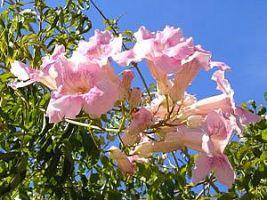The Pink Trumpet Vine (Podranea ricasoliana), is a woody, highly robust, and vigorous climbing plant known for its ornamental flowering. Rapid-growing, this plant can cover structures and walls in very little time. It features long, branched stems that can reach up to 32.8 feet (10 meters) in length. Its leaves are compound, pinnate, with 5 to 7 leaflets of a bright green color. The inflorescences are terminal, sparse, consisting of large, trumpet-shaped, fragrant flowers, pink in color with reddish streaks. Flowering occurs throughout the year, but is most abundant in spring and summer, offering a continuous visual spectacle. Occasionally, it produces fruits, which are long and flattened capsules.
Native to South Africa, Podranea ricasoliana adapts to hot and dry climates but thrives in various weather conditions. Due to its extreme vigor, it should only be supported by strong, large structures such as arbors, pergolas, porches, or walls. It’s vital to consider the strength and durability of the chosen support, given the substantial weight the plant can reach at maturity. It requires initial training and tying up, in addition to annual winter pruning, which controls foliage growth and stimulates more intense flowering. This aspect is essential for maintaining the desired aesthetics in landscaping projects, as well as for the overall health of the plant.
It adapts very well to coastal areas, being a popular choice for coastal gardens, and provides valuable shade on hotter days. It is resistant to soil salinity and sea spray, an important feature for plants in coastal regions. They are frequently visited by carpenter bees (Xylocopa sp), contributing to the pollination of other plants and the biodiversity of the garden.
In landscaping, Podranea ricasoliana is widely used to cover arbors and gazebos, creating cozy, shaded environments. Furthermore, its long-lasting bloom makes it an ideal choice for creating visual interest points in the garden. Its use is not limited to vertical structures; it can also be guided along fences, walls, and other horizontal elements, offering a versatile solution for various landscaping needs. However, care should be taken when planting the Pink Trumpet Vine near trees, as its vigorous growth over branches can overly shade the tree and harm its health.
Many people notice that the Pink Trumpet Vine has a lot of foliage and little flowering, so maintenance is crucial. In this regard, pruning is key in cultivating Podranea ricasoliana. Formative pruning in the first years is essential to ensure the development of a strong structure. Subsequent annual maintenance pruning will help control the size and shape of the plant, as well as stimulate flowering.
This practice is particularly important to keep the plant within desired limits in landscaping projects and prevent excessive growth. Besides its ornamental value, the Pink Trumpet Vine has some practical applications. For instance, in rural areas, it is used to cover structures like sheds and greenhouses, providing shade and helping to regulate the internal temperature.
Pink Trumpet Vines should be cultivated in full sun, in fertile soil enriched with organic matter, with regular watering. They enjoy mild climates and tolerate light frost, losing foliage but sprouting again later. This resilience ensures that the plant can recover from adverse weather conditions. When fertilizing this climber, avoid nitrogenous fertilizations. Prefer adding organic matter and NPK fertilizers rich in phosphorus and potassium with lower nitrogen levels. This nutrient balance will prevent excessive foliage growth and stimulate flowering. Pink Trumpet Vines can be propagated by cuttings, layering, and more rarely by seeds. Cutting is the quickest and most efficient method for propagating the species.
Finally, it is important to highlight that, despite its beauty and utility, Podranea ricasoliana can become invasive under certain conditions. It is essential to be aware of this characteristic and control the plant’s growth, such as through regular pruning and monitoring. This attention to management helps ensure that the Pink Trumpet Vine remains a valuable and manageable component in gardens.


